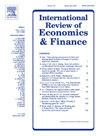The macroeconomic effects of money demand and capital liquidity: A financial accelerator perspective
IF 5.6
2区 经济学
Q1 BUSINESS, FINANCE
引用次数: 0
Abstract
This paper establishes a dynamic stochastic general equilibrium (DSGE) model including secondary asset market and financial accelerator mechanism, to examine the short-term impact of money demand shock and capital liquidity shock through the financial accelerator mechanism on the macro-economy, and compares this impact under two monetary policies (Taylor rule and strict monetary growth rule). Under the two monetary policy rules, the impact of short-term equilibrium change on the level of households’ conditional welfare is also analyzed by using the change of conditional consumption compensation. Our findings reveal that (1) the two shocks affect the price changes of bonds and capital, which in turn affect Fisher rate and capital return changes, then the changes of risk premium, and ultimately macroeconomics via the financial accelerator effect, this is a new channel for the two shocks to affect the macro-economy; (2) The increase of total money demand caused by the increase of shoppers is stronger than that caused by the increase of expected tradability of capital; (3) From the perspective of conditional welfare level, under Taylor rule, households prefer the economy in the steady state of low equilibrium money demand, while it is the opposite under the strict money growth rule, and no matter which monetary policy rule, households more prefer the economy in the steady state of low equilibrium capital liquidity. Finally, the empirical analysis based on SV-TVP-VAR model further verifies the theoretical results of DSGE model.
货币需求与资本流动性的宏观经济效应:金融加速器视角
本文建立了包含二级资产市场和金融加速机制的动态随机一般均衡(DSGE)模型,考察了货币需求冲击和资本流动性冲击通过金融加速机制对宏观经济的短期影响,并比较了两种货币政策(泰勒规则和严格货币增长规则)下的影响。在两种货币政策规则下,利用条件消费补偿的变化分析了短期均衡变化对居民条件福利水平的影响。研究发现:(1)两次冲击影响债券和资本的价格变化,进而影响费雪率和资本收益率的变化,进而影响风险溢价的变化,最终通过金融加速器效应影响宏观经济,这是两次冲击影响宏观经济的新渠道;(2)消费者增加对货币总需求的增加强于资本预期可交易性增加对货币总需求的增加;(3)从条件福利水平的角度来看,在泰勒规则下,家庭更喜欢低均衡货币需求稳态的经济,而在严格货币增长规则下则相反,无论哪种货币政策规则,家庭都更喜欢低均衡资本流动性稳态的经济。最后,基于SV-TVP-VAR模型的实证分析进一步验证了DSGE模型的理论结果。
本文章由计算机程序翻译,如有差异,请以英文原文为准。
求助全文
约1分钟内获得全文
求助全文
来源期刊
CiteScore
7.30
自引率
2.20%
发文量
253
期刊介绍:
The International Review of Economics & Finance (IREF) is a scholarly journal devoted to the publication of high quality theoretical and empirical articles in all areas of international economics, macroeconomics and financial economics. Contributions that facilitate the communications between the real and the financial sectors of the economy are of particular interest.

 求助内容:
求助内容: 应助结果提醒方式:
应助结果提醒方式:


